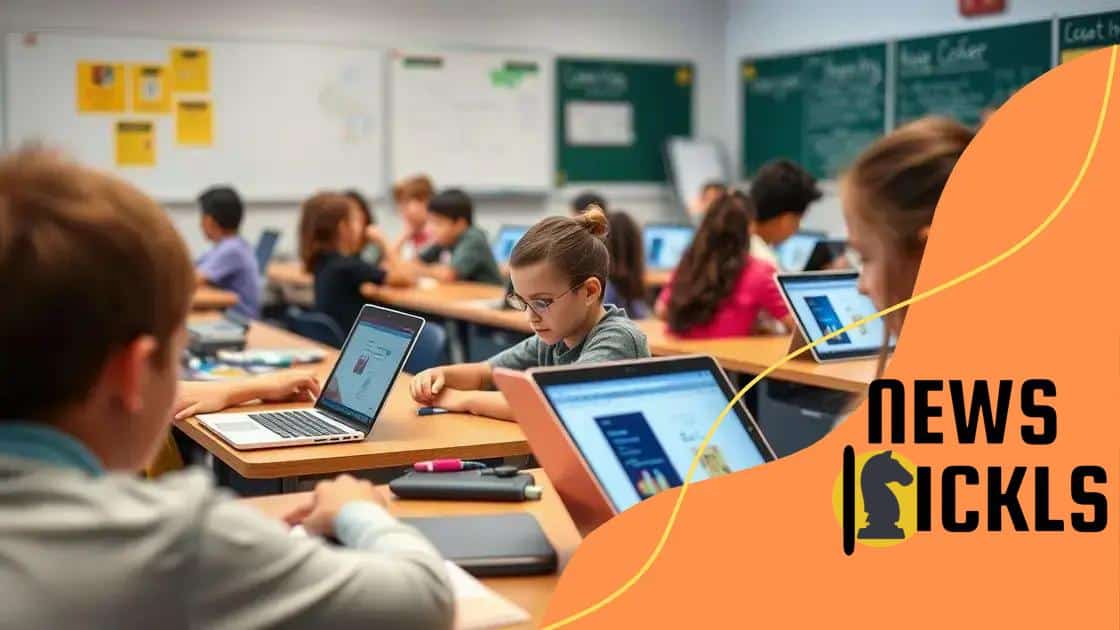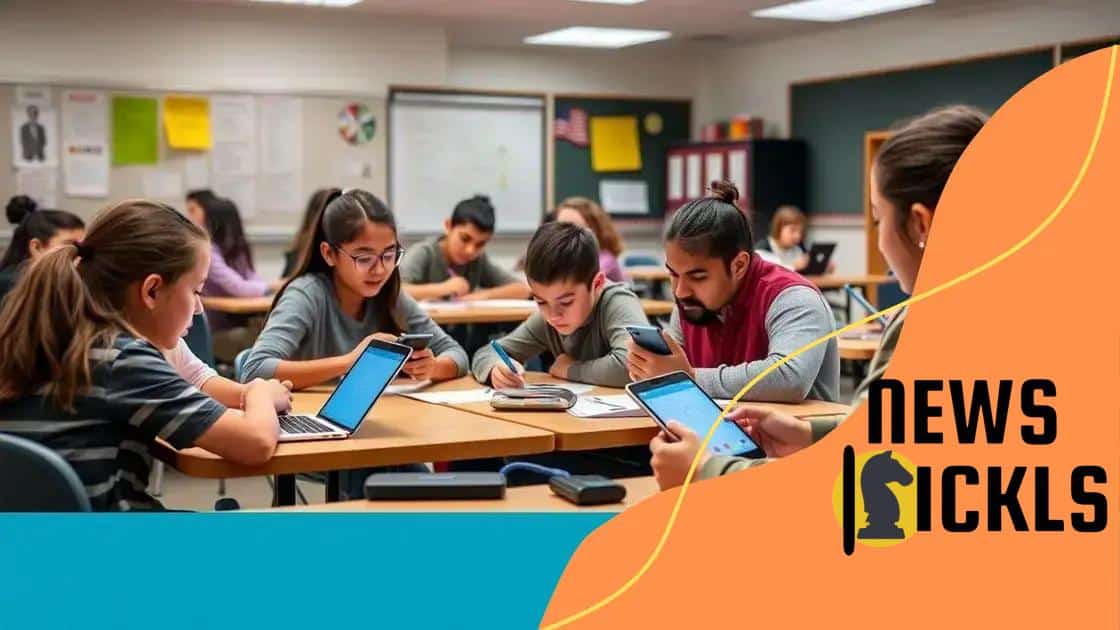How digital literacy is improving academic performance

Improving academic performance through digital literacy involves integrating technology into learning, using innovative assessments, and fostering an engaging, supportive environment that enhances student skills and prepares them for future challenges.
How digital literacy is improving academic performance is a topic that’s more relevant than ever. Have you ever wondered how being tech-savvy can change a student’s learning journey? Let’s dive into it.
Understanding digital literacy
Understanding digital literacy is essential for students in today’s technology-driven world. It involves more than just knowing how to use devices; it includes the ability to access, evaluate, and create information effectively. This skill is crucial for academic success, as it empowers students to engage with diverse learning materials and tools.
What is digital literacy?
Digital literacy encompasses a range of skills that enable individuals to navigate the digital landscape. This includes being able to:
- Identify credible sources of information.
- Use software applications efficiently.
- Communicate effectively through digital platforms.
- Stay safe and secure online.
By developing these skills, students can enhance their learning experiences and contribute meaningfully to discussions both in and out of the classroom.
The importance of digital literacy in education
In an educational context, digital literacy fosters critical thinking and collaboration among peers. Students who are digitally literate can collaborate on projects using online tools, making it easier to share ideas and resources. Furthermore, they can benefit from online courses and educational resources, widening their opportunities for learning.
These skills also prepare students for future careers, where technology plays a vital role. Employers often seek individuals who can navigate digital tools and communicate effectively in a virtual environment. Thus, enhancing digital literacy is not just beneficial for academic performance; it is also a critical component of career readiness.
To foster digital literacy, educators can integrate technology into their lessons, creating interactive and engaging learning experiences. By doing so, they help students build confidence and competence in using digital tools, which in turn boosts their academic performance.
The role of technology in education
The role of technology in education is significant, as it transforms the way students learn and interact with information. Modern classrooms are equipped with various digital tools, making learning more interactive and engaging.
Benefits of technology in learning
Technology provides numerous advantages to students and teachers alike. Some key benefits include:
- Access to a wealth of information online.
- Interactive learning experiences through multimedia.
- Opportunities for personalized education.
- Enhanced collaboration among students.
These benefits contribute to a deeper understanding of subjects and help students develop critical thinking skills.
Technology as a teaching tool
Teachers can leverage technology to enhance their instruction. Digital tools such as interactive whiteboards, educational apps, and learning management systems allow educators to present content in dynamic ways. For example, teachers can use videos to explain complex concepts or create quizzes to assess understanding in real time. This interactivity keeps students engaged and motivated.
Moreover, technology encourages students to take charge of their own learning. They can explore topics of interest through online resources and use tools to collaborate on projects. Such engagement fosters a love for learning and develops lifelong skills.
Furthermore, technology facilitates communication between teachers and students. Platforms like discussion boards and online forums enable students to ask questions and receive feedback promptly. This connection enhances the overall learning experience, as students feel supported in their educational journey.
Impacts of digital literacy on student engagement

The impacts of digital literacy on student engagement are profound and far-reaching. As students become more proficient in using technology, their interest in learning increases significantly. When students engage with digital tools, they can explore topics that intrigue them, leading to a more personalized learning experience.
Increased participation
Digital literacy empowers students to participate actively in their education. They can use online platforms to share ideas, collaborate on projects, and contribute to discussions. This active involvement fosters a sense of belonging and motivates them to engage with the material.
- Students can join online forums and discussion groups.
- Projects can be collaborated on with peers through shared documents.
- Access to a broader range of resources encourages exploration.
- Feedback from teachers can be provided more promptly through digital channels.
With such access, students are more likely to take ownership of their learning process. They feel more in control and can choose how they engage with the content.
Enhanced creativity and critical thinking
Furthermore, digital literacy stimulates creativity in students. When they use various tools to present information, they are encouraged to think outside the box and express their ideas more effectively. By utilizing software for video editing, graphic design, or coding, students can create unique projects that showcase their skills.
Additionally, developing digital literacy enhances critical thinking abilities. Students learn to evaluate sources, discern fact from opinion, and analyze information critically. This skill set is invaluable, as it enables them to approach problems with a more analytical mindset.
As they navigate online landscapes, students become adept at questioning information and seeking reliable resources. This critical engagement not only boosts their performance but also prepares them for real-world challenges in a digital age.
Strategies for improving digital literacy
Strategies for improving digital literacy are essential for helping students thrive in a technology-driven world. By implementing effective techniques, educators can enhance students’ skills and confidence in using digital tools. Here are some effective approaches that can be undertaken.
Encourage hands-on learning
Hands-on learning is key to developing digital literacy. Engaging students in practical activities allows them to explore technology in a meaningful way. For example, conducting workshops on coding or video creation can spark interest and inspire creativity. Students learn best when they can apply their knowledge in real-world scenarios.
- Host technology workshops to teach new skills.
- Incorporate project-based learning that uses digital tools.
- Encourage group work that utilizes technology for collaboration.
- Provide access to resources, such as educational apps and websites.
This hands-on experience makes the learning process enjoyable and impactful.
Integrate technology across the curriculum
Another effective strategy is integrating technology into various subjects. Rather than teaching digital skills in isolation, embedding them into the curriculum allows students to see the relevance of their learning. For instance, using a research project in science will help students learn information literacy while exploring scientific concepts.
Furthermore, by using different tools, such as digital presentations or online quizzes, teachers can make lessons more interactive. This integration fosters a deeper understanding of both the content and the technology involved.
Foster a supportive environment
Creating a supportive environment is crucial for developing digital literacy. Teachers should encourage students to ask questions and take risks with their learning. When students feel safe to experiment with technology, they are more likely to explore and learn effectively.
Additionally, providing ongoing feedback is important. Constructive feedback helps students identify areas for improvement and boosts their confidence as they develop their skills.
Measuring academic performance with digital skills
Measuring academic performance with digital skills has become increasingly important in today’s education system. As technology integrates into learning, evaluating how well students can use these skills gives educators valuable insights into their overall performance. This method goes beyond traditional testing and focuses on practical applications of knowledge.
Understanding digital assessments
Digital assessments allow teachers to measure student understanding in real-time. These assessments can take many forms, such as online quizzes, projects, or presentations. By using digital tools, teachers can assess students’ abilities to engage with content and demonstrate their learning effectively.
- Online quizzes provide immediate feedback on student performance.
- Project-based assessments encourage creativity and problem-solving.
- Digital portfolios allow students to showcase their work over time.
- Interactive platforms facilitate collaborative assessments among peers.
This approach not only gauges academic performance but also helps students develop essential digital literacy skills.
The role of analytics in education
Analytics play a vital role in measuring academic performance. Through the use of learning management systems, educators can track student progress and identify areas where they may struggle. Such data-driven insights allow for tailored teaching strategies that address individual student needs.
Moreover, analytics can help in identifying trends within class performance. Consequently, educators can implement necessary changes in their teaching methods, ensuring that all students have the support they need to succeed.
Using digital skills to assess academic performance not only enriches the learning experience but also prepares students for future careers where these abilities are crucial. Employers value candidates who are not only knowledgeable but also adept at using technology for problem-solving.
FAQ – Frequently Asked Questions about Digital Literacy and Academic Performance
How does digital literacy improve student engagement?
Digital literacy enhances student engagement by making learning interactive and relevant. When students use technology, they can participate in discussions and collaborate on projects.
What tools can be used to measure academic performance with digital skills?
Tools like online quizzes, digital portfolios, and learning management systems can provide insights into student performance and track their progress over time.
Why is a supportive environment important for developing digital skills?
A supportive environment encourages students to explore technology without fear of failure, boosting their confidence and willingness to learn new skills.
How can teachers integrate technology into their lessons effectively?
Teachers can integrate technology by using project-based learning that incorporates digital tools or through interactive sessions that enhance collaboration and creativity.






